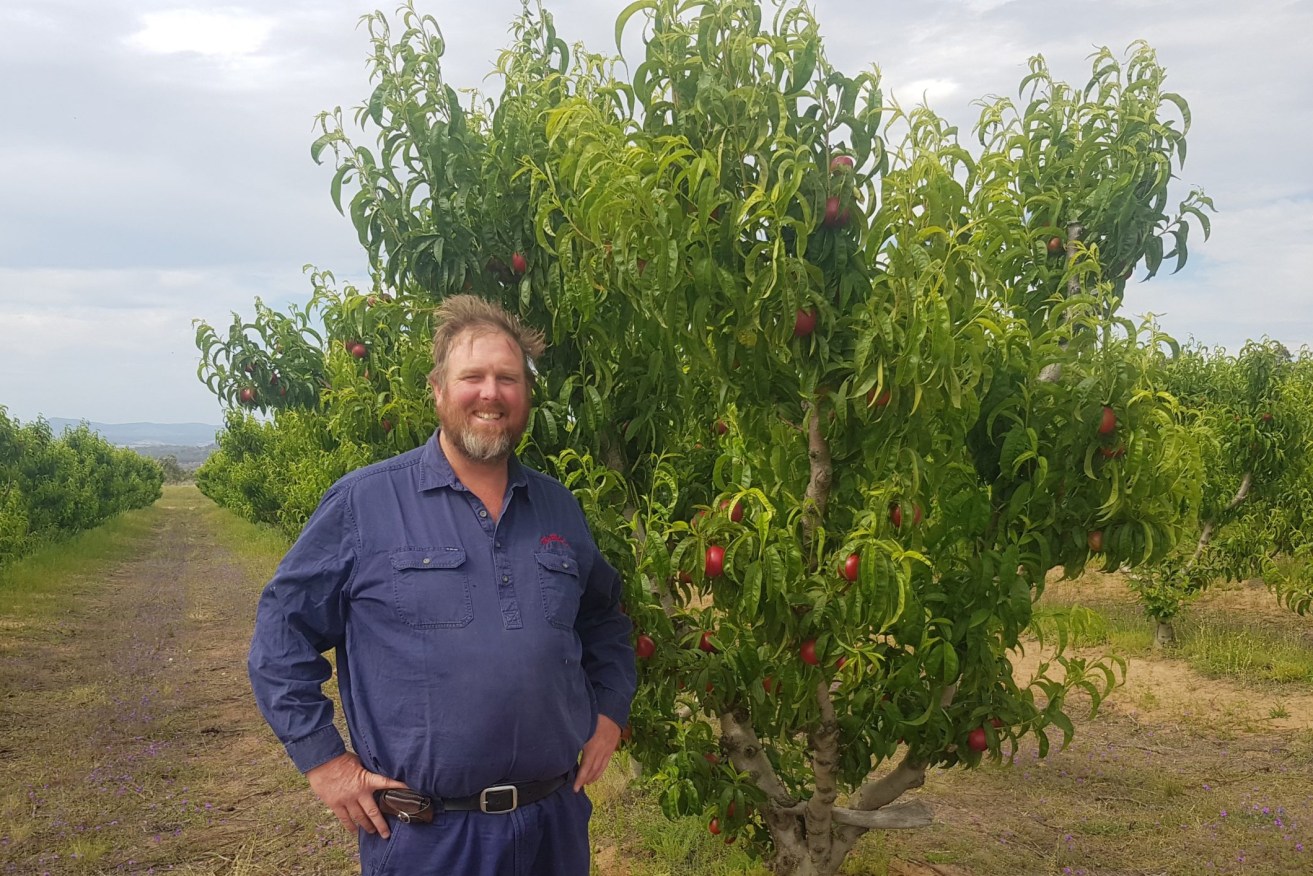Ripe for the picking: why COVID is forcing a rethink on farm labour
Coronavirus may have dried up the pool of foreign workers available to farmers for this season’s harvest, but is there an appetite for changing how agriculture recruits its workforce?


Granite Belt stone fruit grower Gus Ferrier. (Photo: Supplied).
Stone fruit grower Gus Ferrier is confident he has labour sorted for when picking starts at his Granite Belt orchard this week.
After nursing his 18,000 trees through years of drought and staring down severe bushfires last summer, Ferrier says combatting worker shortages is just another challenge that farmers in his position will resolve.
“We build steadily in preparation of the peak to come, he said.
“I haven’t heard that any farmer among our group can’t get the staff they need to get started.
“Nor have I heard anyone expressing the view that there is stacks of backpackers sitting around waiting for jobs.
“But there’s no sense of panic. Farmers are experts when it comes to planning for all the problems that can come their way.”
Ferrier heads the Granite Belt Growers Association and saw the labour drain early when Coronavirus travel restrictions decimated the industry’s traditional backpacker workforce.
It’s left some farms around the country with crops to rot or cultivated ground fallow, stranded by the absence of foreign harvest workers and the seeming reluctance of under-employed Australians to pick up the slack.
That dynamic has set in train several sweeteners from government to fill the void, most notably the Morrison Government’s $17.4 million relocation assistance announced in last week’s federal budget and a $1500 travel subsidy announced last month by the Queensland Government to assist workers as they move between growing regions over the coming months.
Ferrier says the scheme will help farmers on the Granite Belt, who will need about 4000 full-time equivalent workers for the duration of the season from this month until April next year.
His association of about 50 farmer members have marshalled forces to create the Harvest Army, a program that’s devoted to recruiting newcomers to the ranks and mobilising pickers who may be finishing up in other regions.
At the time of writing, harvest workers finishing the strawberry harvest around Bundaberg are marching south to the Stanthorpe district, where they could feasibly stay employed until April next year.
“We started the program early so in many respects we were ahead of the curve before it became a problem,” Ferrier said.
“We’re still getting really strong inquiry and we’re not discriminating between foreign workers or Australians – we just want highly motivated people who want to do a fair day’s work.”
Solid living
Ferrier has his picking team of 14 locked in for his Rosemary Hill farm at Pikedale, 30 minutes west of Stanthorpe.
He doesn’t just look for hard workers who are physically fit and work well in teams, but people who know the look of quality produce, as only the best fruit should be picked to meet exacting retail specifications.
Ferrier cites a flat hourly rate of $24.30 per hour less tax as the going amount, although some farmers will pay a piece rate depending on the volumes their workers harvest.
Good pickers can earn anywhere up to $40 an hour, with those at the lower end receiving half that rate.
“A good fruit and vegetable picker, who’s prepared to put in the work can have a full book of employers all year-round and earn a very good living, moving between regional communities where the cost of living is lower,” he said.
“It can be a great way of life for many people.”
Ferrier and farming groups generally are hoping the positive attributes of farm work will cut through, especially in a labour market currently on JobKeeper support until the economy reboots and the best talent heads back towards hospitality and tourism.
The alternative for farmers and food security generally could be dire if reinforcements fail to arrive in substantial numbers.
Queensland Department of Agriculture modelling puts the worker shortage at 7000 state-wide across key horticulture regions towards the end of this year.
Pressure on the shortfall will intensify next year as working holidaymaker numbers continue to decline and services sectors begin to reopen if the pandemic remains under control, according to a department spokesperson.
Major commodities where Queensland can expect to see a shortfall of workers include citrus, berries, mangoes, bananas and vegetables.
That will mean high impact for communities such as northern Moreton Bay, Sunshine Coast, Wide Bay, Mackay Isaac Whitsunday, the Granite Belt, the Darling Downs and Maranoa, and to a lesser extent north and central Queensland.
The labour squeeze will also tighten for other agricultural enterprises that traditionally use casual foreign workers – admittedly in smaller numbers but which require higher levels of skill such as station hands on beef holdings or working irrigation lines on cotton farms.
Farming’s image problem
Despite more people now jobless as a result of COVID, no one is suggesting they will naturally gravitate to opportunities in the bush, given the long distance from major centres and cities, the variable living and working conditions and the industry’s sustained image problem as an employer with a patchy record on fairly treating its employees.
These obstacles have been outlined in an interim Commonwealth parliamentary committee report into Australia’s Working Holiday Maker program released last month.
A key submission to the inquiry was made by the Migration Institute of Australia, who has asked for a national 24-hour hotline to be established for workers in need of urgent assistance and support if they feel unfairly treated while working in remote locations.
The institute’s national vice president, Brisbane-based migration agent, Leanne Stevens, told InQueensland that their submission highlighted this as a priority due to widespread concerns over the exploitation of foreign visa holders that “in many cases amount to modern slavery”.
Her position is backed by University of Southern Queensland academic Dr Chris Kossen, whose study of backpackers working in the Lockyer Valley in 2017-18, showed deep levels of discontent with working conditions and anger towards their employers.
Kossen says the toxic work environment he studied was fed by severe power imbalances hard-wired into the working arrangements governing large-scale foreign labour programs.
For many foreign workers under 30 looking to extend their visas by one year, the government mandates 88 days of employment in a rural industry – a program that was devised to bolster the workforce in remote locations.
According to Kossen, that’s created an environment of acute vulnerability for people on modest incomes and often with language and cultural barriers, willing to withstand substandard treatment out of sheer desperation.
“So, when you have an abundance of people and an industry that knows these people need to work to get their extra year in Australia, it creates the kinds of conditions that are ripe for exploitation,” he said.
Ferrier concedes the industry has been tarnished by rogue operators in the minority, but is adamant most farmers treat their workers well, while his organisation endorses the use of ethical employment programs such as Fair Farms and Sedex.
While Australia has no foreign workers coming in, the country also has none of its citizens leaving either, creating the opportunity for graduating high school and university students to have a type of “gap year” in the bush, rather than head overseas.
That’s one of the recommendations the Parliamentary Committee led by NSW Liberal MP Julian Leeser has made as a matter of urgent priority, to develop a “Have a Gap Year at Home Campaign” to attract young Australians to regional work.
His committee is hoping the idea will win favour with young people with a sense of patriotism and spirit of adventure.












